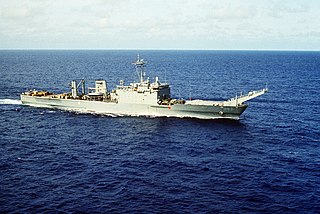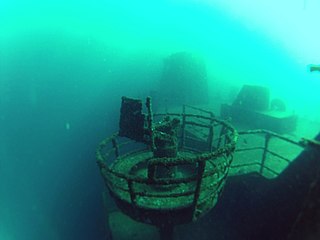
The Santa María class of guided missile frigates is the Spanish Navy's designation for six warships based on the United States Oliver Hazard Perry-class frigates. Spanish ships have a slightly bigger beam and were built with a greater weight reserve for future improvements. Other changes from the basic model include Meroka replacing Phalanx and a RAN-12L air search radar to provide low horizon coverage against sea skimmers cueing the Meroka CIWS mount. The Nettunel EW suite replaced the SLQ-32 system fitted aboard US ships. The first ship Santa Maria entered service in 1986.

USS Frederick (LST-1184) was a Newport-class tank landing ship which replaced the traditional bow door-design tank landing ships (LSTs) of the United States Navy. The ship was named after the city of Frederick, Maryland and Frederick County, Maryland. The vessel entered service in 1970 with the United States Pacific Fleet and saw service during the Vietnam War, and the Persian Gulf War earning three battle stars. The ship was decommissioned in 2002 and put up for sale.

Newport-class tank landing ships were an improved class of tank landing ship (LST) designed for and employed by the United States Navy from 1969 to 2002. The ships were intended to provide substantial advantages over their World War II-era predecessors. Larger and faster than any previous LST design, they carried a ramp over the bow that allowed them to surpass 20 knots, a goal of the United States amphibious forces. 27 were planned of which twenty were completed, the high number due to the demands of US force projection estimates. However, the arrival of the air-cushioned landing craft which allowed for over-the-horizon attacks made the class obsolete in the eyes of the United States Navy. Placed in reserve, twelve were eventually sold to foreign navies, while the remaining eight have since been decommissioned.

USS Newport (LST-1179) was the third ship of the United States Navy (USN) to bear the name of the Rhode Island city. The first of her class of landing ship tanks (LST), she was capable of a sustained speed of 20 knots. Her ability to adjust her draft, accompanied by her unique bow-ramp design, helped bring a new degree of responsiveness to the amphibious fleet. The ship was launched in 1968 and entered service with the USN in 1969. Assigned to the United States Atlantic Fleet for the entirety of her career, Newport made deployments to the Mediterranean and Caribbean Seas. The vessel was taken out of service in 1992 and laid up until 2001.

HMCS Vancouver, was a Thornycroft S-class destroyer, formerly HMS Toreador built for the Royal Navy in 1917–1919. Seeing limited service with the Royal Navy, the ship was loaned to the Royal Canadian Navy in March 1928. The destroyer served primarily as a training vessel until 1936 when the vessel was discarded.

HMCS CH-15 was a H-class submarine originally ordered for the Royal Navy as H15 during the First World War. Constructed in the United States during their neutrality, the submarine was withheld from the Royal Navy until after the US entry into the war. Entering service at the very end of the war, the submarine saw no action and was laid up at Bermuda following the cessation of hostilities. The British government gave the submarine to Canada in 1919, and it was in service with the Royal Canadian Navy from 1921 to 1922 as CH-15. The submarine was sold for scrap and broken up in 1927.

USS Peoria (LST-1183) was a Newport-class tank landing ship which replaced the traditional bow door-design tank landing ships (LSTs). The vessel took part in the Vietnam War and Gulf War. The ship was constructed by the National Steel and Shipbuilding Company in San Diego, California and was launched in 1968 and commissioned in 1970. Named for a city in Illinois, Peoria was assigned to the United States Pacific Fleet and home ported at San Diego. The tank landing ship alternated between military exercises along the United States west coast and deployments to the western Pacific. Peoria took part in the evacuations of Phnom Penh, Cambodia and Saigon, South Vietnam, both of which signaled the end of American involvement in the respective countries. The vessel was decommissioned 1994 and sunk as a target ship during a RIMPAC naval exercise in 2004.

USS Barbour County (LST-1195) was the seventeenth ship of the twenty Newport-class tank landing ships of the United States Navy (USN) which replaced the traditional bow door-design tank landing ships (LSTs). The vessel was named after two counties; one in Alabama, and the other in West Virginia. The LST was constructed by National Steel and Shipbuilding Company of San Diego, California. Barbour County was launched in 1971 and commissioned into the USN in 1972. Barbour County took part in the Vietnam War, including the evacuation of Saigon and the Gulf War. The LST also performed disaster relief in Bangladesh. The vessel was decommissioned in 1992 and laid up with plans to sell the ship. This did not happen and the vessel was struck from the Naval Vessel Register in 2001 and sunk as a target ship in 2004.

USS Boulder (LST-1190) was the twelfth of twenty Newport-class tank landing ships of the United States Navy (USN) which replaced the traditional bow door-design tank landing ships (LSTs). Named after the county in Colorado, the ship was constructed by National Steel and Shipbuilding Company of San Diego, California. The LST was launched in 1970 and was commissioned in 1971. Boulder was assigned to the United States Atlantic Fleet and deployed in the Caribbean and Mediterranean Seas. In 1980, the ship was transferred to the Naval Reserve Force. In 1988, Boulder ran aground off Norway during a military exercise. The vessel was decommissioned in 1994 and laid up at the Naval Inactive Ship Maintenance Facility in Philadelphia, Pennsylvania. The ship was struck from the Naval Vessel Register in 2008 and towed to Brownsville, Texas for scrapping in 2022.

USS Manitowoc (LST-1180) was the second ship of the Newport-class tank landing ships which replaced the traditional bow door-design tank landing ships (LSTs) in service with the United States Navy. Manitowoc was constructed by the Philadelphia Naval Shipyard in Philadelphia, Pennsylvania and launched in 1969 and entered service in 1970.
HMCS Miramichi was a Bay-class minesweeper that served in the Royal Canadian Navy and the French Navy. She was named Miramichi Bay, located at the mouth of the Miramichi River in New Brunswick. Entering service in 1954, the vessel served in the Royal Canadian Navy for only a few months before transferring to the French Navy. Renamed La Lorientaise, the ship was used as a minesweeper before converting to a patrol vessel in 1973. The ship was discarded in 1986.

USS Fresno (LST-1182) was the fourth tank landing ship (LST) of the Newport class. Fresno was named for a county in California. The vessel was constructed by the National Steel and Shipbuilding Company in San Diego, California and launched in 1968. The ship entered service in 1969 and was assigned to the United States Pacific Fleet, taking part in training along the west coast and operational cruises to the western Pacific, taking part in the Vietnam War. Fresno was decommissioned in 1993 and laid up. The LST was nearly sold to Peru but remained in the U.S. inventory until 2014, when Fresno was sunk as a target ship in the Pacific Ocean during a training exercise off Guam.

The R boats were a group of small naval vessels built as minesweepers for the Kriegsmarine before and during the Second World War. They were used for several purposes during the war, and were also used post-war by the German Mine Sweeping Administration for clearing naval mines.

USS Fairfax County (LST-1193) was the fifteenth of twenty Newport-class tank landing ships of the United States Navy (USN) which replaced the traditional bow door-design tank landing ships (LSTs). Named after a county in Virginia, the ship was constructed by National Steel and Shipbuilding Company of San Diego, California. The LST was launched in 1970 and was commissioned into the USN in 1971. Fairfax County was alternated deployments between the Caribbean Sea and the Mediterranean Sea. During the Gulf War, Fairfax County was deployed off the northern African coast as part of a deterrent force. The ship was decommissioned from the USN in 1994.

USS Bristol County (LST-1198) was the last of the twenty Newport-class tank landing ships of the United States Navy (USN) which replaced the traditional bow door-design tank landing ships (LSTs). The LST was constructed by National Steel and Shipbuilding Company of San Diego, California. Bristol County was launched in 1971 and commissioned into the USN in 1972. Bristol County was assigned to the United States Pacific Fleet and remained in service until 1994 when it was decommissioned. Sold to Morocco that year, the vessel was recommissioned into the Royal Moroccan Navy as Sidi Mohammed Ben Abdellah. The ship remains in service.

BAP Abtao (SS-42) is an Abtao-class submarine of the Peruvian Navy. The vessel which was originally named BAP Tiburón ("Shark"), was constructed by the American Electric Boat company in the United States and launched in 1953. The Abtao class were the last submarines constructed by the United States for the export market. The submarine entered service in 1954 and by presidential decree, was renamed Abtao for the battle during the Chincha Islands War.
Dat Assawari was a frigate operated by the Libyan Navy. The ship was built by VT Group in the United Kingdom. It was ordered in February 1968 and delivered in 1973. The ship's design, the Vosper Mk 7 is a modified version of the Alvand-class frigate built for the Iranian Navy. The ship had an extensive refit in Italy by CNR Riva Trigoso 1979–1980 when new sensors and missiles were installed. During the refit, the ship was mined by French commandos from SDECE. The vessel returned to service in 1983, but returned to Italy for repairs in 1984–1985 and 1989–1990. The frigate was reportedly scrapped in the late 1990s.

The Admiral Pereira da Silva class of frigates, also known as Admiral-class frigates, were in the service of the Portuguese Navy between 1966 and 1985. The class was based on the Dealey-class destroyer escort of the United States Navy. The three ships of the class were built in Portugal, at the Lisnave shipyards and the shipyards of Viana do Castelo. The construction of the ships was part of the effort of Portugal to expand its fleet in the face of unrest in the empire and was financed by the United States via the Mutual Defense Assistance Program. Financial problems prevented them from ever being modernised and they were deleted in 1989.
HMCS Fundy was a Bay-class minesweeper that was constructed for the Royal Canadian Navy during the Cold War. The minesweeper entered service in March 1954 and was transferred later that month to the French Navy. Renamed La Dunkerquoise, the ship was converted to a territorial patrol vessel in 1973 and remained in service until 1984. La Dunkerquoise was discarded in 1986.

Al Munassir was an amphibious warfare vessel operated by the Royal Navy of Oman. It was purchased to enable the kingdom to respond to threats to the strategically important Musandam Governorate. The vessel was launched in 1978 and, after decommissioning, was sunk as an artificial reef in 2003. It is now a popular diving site.
















